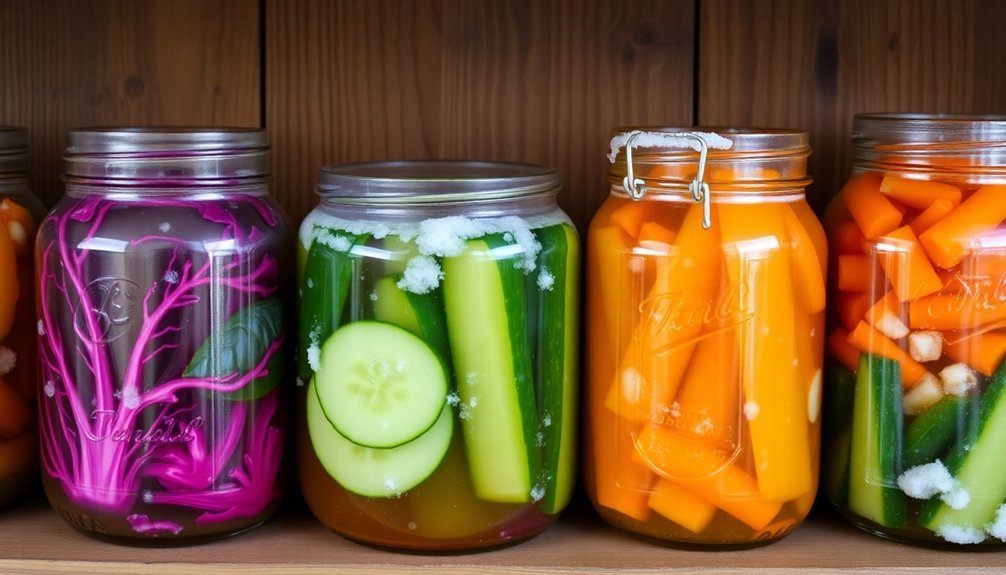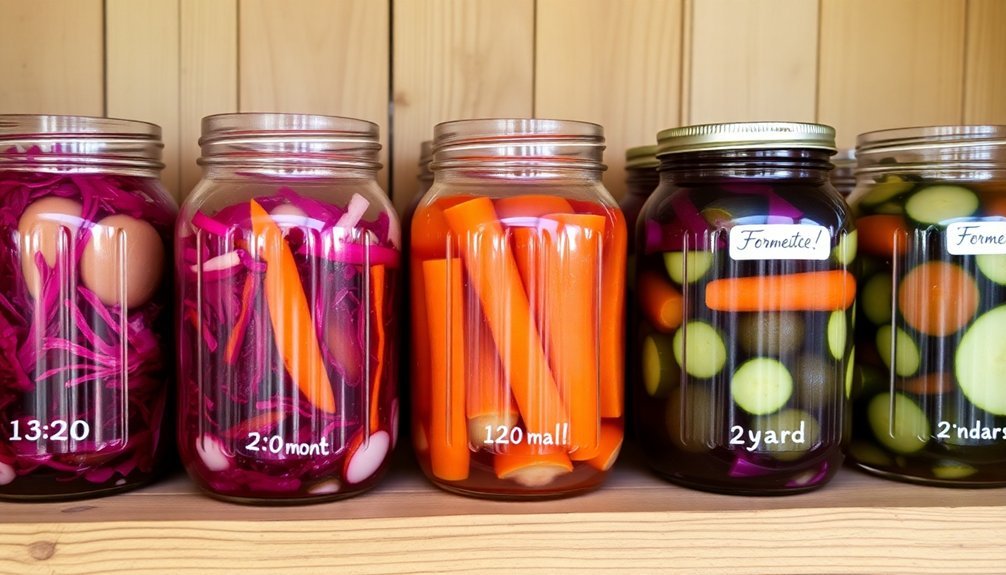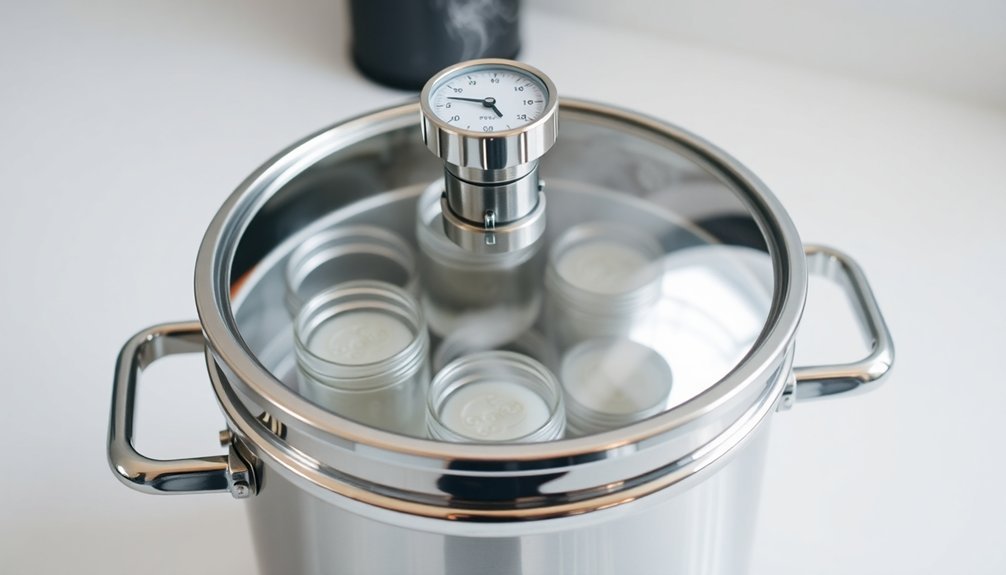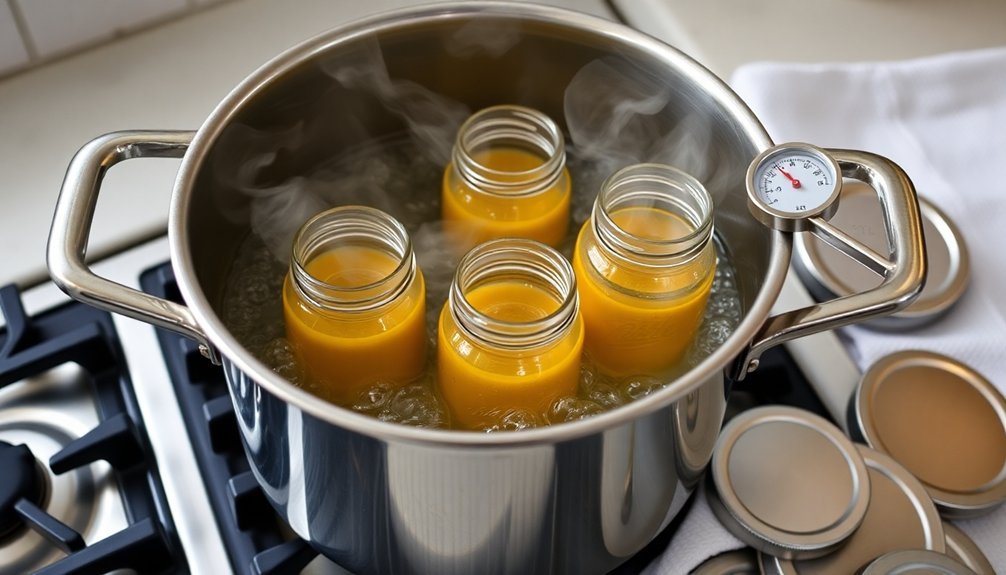Properly fermented vegetables can last up to 1 year or longer when stored correctly. You'll need to keep them in sterilized, airtight containers at temperatures between 32-50°F, with 39-41°F being ideal. Common ferments like sauerkraut will stay fresh for about 3 months in your fridge, while fermented fruits have a shorter shelf life of a few weeks to a month. To maximize preservation, guarantee vegetables stay submerged in brine and avoid disturbing the contents. Watch for quality indicators like pleasant tanginess and crispness, while monitoring for any signs of spoilage. The journey to mastering fermentation preservation holds many more essential tips and techniques.
Natural Preservation Duration

Through the remarkable process of fermentation, vegetables can remain preserved for an impressively long time. When properly fermented, your vegetables can last up to a year or even longer, thanks to the natural preservation mechanisms at work. The key players in this process are Lactic Acid Bacteria (LAB), which convert carbohydrates into acids and create an environment where harmful bacteria can't thrive.
You'll find that the fermentation process achieves a significant 5-log reduction in dangerous pathogens like E. coli, Salmonella, and L. monocytogenes. This natural preservation occurs as the LAB produce acid, which lowers the pH and creates conditions that are hostile to harmful microorganisms. Proper refrigeration immediately halts fermentation, ensuring optimal preservation of your fermented vegetables.
While different fermented vegetables have varying shelf lives, items like sauerkraut and fermented cucumber pickles can stay fresh in your refrigerator for up to 3 months.
It's worth noting that fermented fruits don't last as long as vegetables, typically maintaining their quality for only a few weeks to a month due to their alcohol content. For ideal preservation, you'll want to aim for temperatures below 60°F but above 32°F, which allows the beneficial bacteria to continue their preservation work at a controlled pace.
Proper Storage Requirements
Maximizing the shelf life of your fermented vegetables depends heavily on proper storage techniques. You'll need to store your ferments in specific containers and locations to maintain their quality and prevent spoilage.
Ideal storage temperatures should be kept between 32-50°F for optimal preservation. Choose fermentation-specific containers like Fido jars or pickle pipes, which allow gases to escape while preventing contamination. Keep the lids on but not overly tight, and guarantee your brine levels remain high enough to cover the vegetables completely.
When you've consumed more than a quarter of the ferment, transfer it to a smaller, clean container to reduce headspace and minimize spoilage risks.
For storage locations, your refrigerator is ideal as it slows down fermentation. If that's not possible, use a cool cellar, basement, or the coolest corner of your kitchen. You'll want to keep your ferments away from direct sunlight and in dark locations whenever possible.
Monitor your ferments regularly for any signs of mold or unwanted growth on the surface.
For long-term storage, you can freeze your ferments in plastic containers or straight-sided mason jars, which will completely stop the fermentation process and preserve them for up to six months.
Optimal Temperature Control

For your fermented vegetables to last longer, you'll need to maintain temperatures between 60°F and 70°F (16°C-21°C) during the fermentation process.
Once fermentation is complete, you should move your vegetables to cold storage at around 40°F (4°C) to greatly slow down bacterial activity and preserve the crisp texture. Regular temperature monitoring using a thermometer that displays current, high, and low readings helps ensure optimal storage conditions.
At these colder temperatures, your properly fermented vegetables can maintain their quality for several months while developing complex flavors.
Cold Storage Benefits
Cold storage mastery plays an essential role in preserving your fermented vegetables' quality and extending their shelf life. When you store your ferments in cool conditions, you'll effectively slow down the fermentation process, which helps maintain the ideal texture and flavor profile of your vegetables.
This controlled environment prevents your ferments from becoming overly sour or mushy while reducing the risk of unwanted mold and yeast growth.
You've got several reliable storage options to choose from. Your refrigerator provides the most consistent cool temperature, while a basement or root cellar offers natural cooling that's perfect for ferments.
If you're limited on space, a wine cellar or even a cool corner of your apartment can work effectively.
To maximize your ferments' longevity, you'll need to maintain proper storage conditions. Keep your vegetables submerged in brine, minimize how often you open the jars, and use appropriate lids that allow for some gas exchange.
When stored correctly in cool conditions, your fermented vegetables can last a year or more, with some lasting indefinitely. Regular monitoring of their condition and flavor will help guarantee they remain at peak quality.
Ideal Temperature Ranges
Maintaining precise temperature control stands at the heart of successful fermentation, with the ideal range falling between 60°F and 70°F (16°C – 21°C).
You'll achieve the best results at around 65°F (18°C), where beneficial bacteria like Lactobacillus thrive and create the perfect balance of flavors and textures.
If your fermentation temperature climbs above 70°F (21°C), you'll notice faster acid production, but at a cost. Your vegetables will become mushy, and you'll end up with sharper, funkier flavors.
The higher heat also encourages less desirable bacteria that won't produce the CO2 needed for proper fermentation.
Temperatures below 58°F (14°C) create their own challenges. While cooler conditions help maintain crunchier vegetables, they greatly slow down the fermentation process.
This delay can give harmful bacteria and molds an opportunity to take hold, compromising your ferment's safety and quality.
To maintain ideal temperatures, you'll need to adjust your fermentation time based on your environment.
In warmer conditions, check your ferments more frequently and consider adding extra salt. For cooler spaces, expect longer fermentation times to achieve the desired acidity levels.
Signs of Ferment Quality
Knowing the signs of a healthy fermentation process helps you avoid consuming spoiled food and guarantees ideal flavor development. Watch for active bubbling in the brine and slight carbonation, which indicate proper lactic acid fermentation is occurring.
You'll notice the brine becoming cloudy, and your vegetables may slightly fade in color – these are normal changes. Your fermented vegetables should maintain their crispness while developing a pleasant, tangy flavor that's both sour and salty.
You'll want to taste them daily to monitor their progression. The aroma should be sour but not offensive, similar to vinegar. When you open the vessel, you might notice a strong smell that quickly dissipates – this is just trapped fermentation gases escaping.
Be alert for warning signs of spoilage. If you spot any mold, especially pink or fuzzy growth, discard the batch immediately. Don't consume vegetables that have become mushy or develop an unpleasant, putrid smell.
The brine should remain clear to slightly cloudy, never murky. If tasting causes stomach discomfort or you notice a strong, unpleasant yeasty smell, it's best to start fresh with a new batch.
Extended Storage Methods

For ideal preservation of your fermented vegetables, you'll want to store them in cold conditions between 39°F and 41°F (4°C and 5°C), such as in a refrigerator or root cellar.
You can extend storage life further by keeping ferments in sterilized, airtight containers and ensuring vegetables stay fully submerged in brine.
While refrigeration is the most common method, you can also freeze fermented vegetables to dramatically extend their shelf life, though this may slightly alter their texture.
Cold Storage Best Practices
To maximize the shelf life of your fermented vegetables, proper cold storage techniques are crucial. The ideal storage temperature ranges between 32-50°F (0-10°C), with 39°F (4°C) being ideal for preserving both flavor and texture. Your refrigerator provides the most reliable environment, effectively halting fermentation and maintaining quality.
If you don't have sufficient fridge space, you can store your ferments in a cold basement, root cellar, or vegetable cellar, where temperatures typically stay between 45-65°F. Just make sure you're keeping the temperature below 70°F, as warmer conditions will speed up fermentation and reduce storage life.
When transferring your ferments to cold storage, make sure they've reached your desired level of sourness first. Keep the jars tightly sealed to prevent oxygen exposure and maintain proper brine levels – your vegetables should always stay submerged.
Don't disturb the contents once they're in storage, as this can introduce unwanted bacteria. If you're using metal lids, check them regularly for rust and consider switching to plastic alternatives.
While some surface yeast or harmless white film may develop, proper cold storage considerably reduces these occurrences.
Freezing For Maximum Longevity
Freezing your fermented vegetables offers an excellent way to extend their shelf life well beyond traditional refrigeration methods.
You'll want to verify the fermentation process has completed or considerably slowed before transferring your vegetables to freezer-safe containers or heavy-duty bags. Leave about 1/2 inch of headspace to accommodate expansion during freezing, and don't forget to label everything with dates.
Store your frozen fermented vegetables at 0°F (-18°C) or below in the coldest part of your freezer. You'll need to use airtight containers to prevent freezer burn and maintain quality.
While frozen sauerkraut can last up to 12 months, you'll get the best quality within the first 8 months of storage.
When you're ready to use your frozen fermented vegetables, thaw them in the refrigerator or at room temperature. Once thawed, plan to use them within a few days for best flavor and nutritional benefits.
You can incorporate thawed sauerkraut into salads, stir-fries, or serve it as a side dish. While the texture might change slightly, you'll still retain most of the nutrients and beneficial probiotics from the fermentation process.
Safety and Spoilage Prevention
Successful fermented vegetable preservation depends on maintaining strict safety protocols and preventing spoilage throughout the process.
You'll need to start with properly cleaned and sanitized containers, while guaranteeing all surfaces and equipment are thoroughly disinfected. Always wash your hands frequently and use potable water when rinsing vegetables.
To prevent contamination, select fresh, firm vegetables and cut them uniformly no more than 24 hours before starting fermentation. You'll want to use the correct amount of food-grade pickling salt, ranging from 2-20% depending on your recipe. Keep vegetables fully submerged under brine and maintain anaerobic conditions using an airlock lid.
Monitor your fermentation daily, keeping the temperature between 68-72°F. Watch for warning signs of spoilage like slimy textures or off-putting smells. Confirm the pH stays at 4.6 or lower to prevent C. botulinum risk.
Remember that Listeria can survive in refrigerated pickled vegetables for months, so hold your completed ferments for at least two weeks before distribution. This waiting period allows acid-tolerant pathogens to die off, making sure your fermented vegetables are safe to consume.
Frequently Asked Questions
Can I Reuse the Brine From Finished Fermented Vegetables for New Batches?
Yes, you can reuse brine from finished ferments for new batches. Just add 1/2 cup to a quart jar of fresh vegetables. It'll speed up fermentation and boost probiotic content in your next batch.
Do Different Vegetables Have Different Optimal Fermentation Times?
Yes, you'll find different vegetables need varying fermentation times. Harder veggies like carrots take longer than soft ones like cucumbers. Temperature also affects timing, and you can taste-test to find your preferred flavor.
What Happens if I Accidentally Leave Fermented Vegetables at Room Temperature Overnight?
If you've left fermented vegetables out overnight, they're likely still safe. You'll notice increased sourness and softer texture. Check for mold or off-smells, then return them to the fridge to slow fermentation.
Should I Rinse Fermented Vegetables Before Eating Them?
You shouldn't rinse fermented vegetables before eating them as you'll wash away beneficial probiotics and nutrients in the brine. The brine is an essential part of the fermentation process and its health benefits.
Can I Mix Different Types of Vegetables in the Same Fermentation Jar?
Yes, you can mix different vegetables in the same fermentation jar. Just keep in mind that softer vegetables will ferment faster than dense ones, so choose vegetables with similar textures for the best results.
In Summary
You'll find that properly fermented vegetables can last several months to a year when you store them correctly. Remember to keep your ferments in airtight containers, maintain consistent refrigeration temperatures, and check regularly for signs of spoilage. By following proper storage methods and safety guidelines, you'll be able to enjoy your homemade fermented vegetables for extended periods while preserving their probiotic benefits and unique flavors.





Leave a Reply